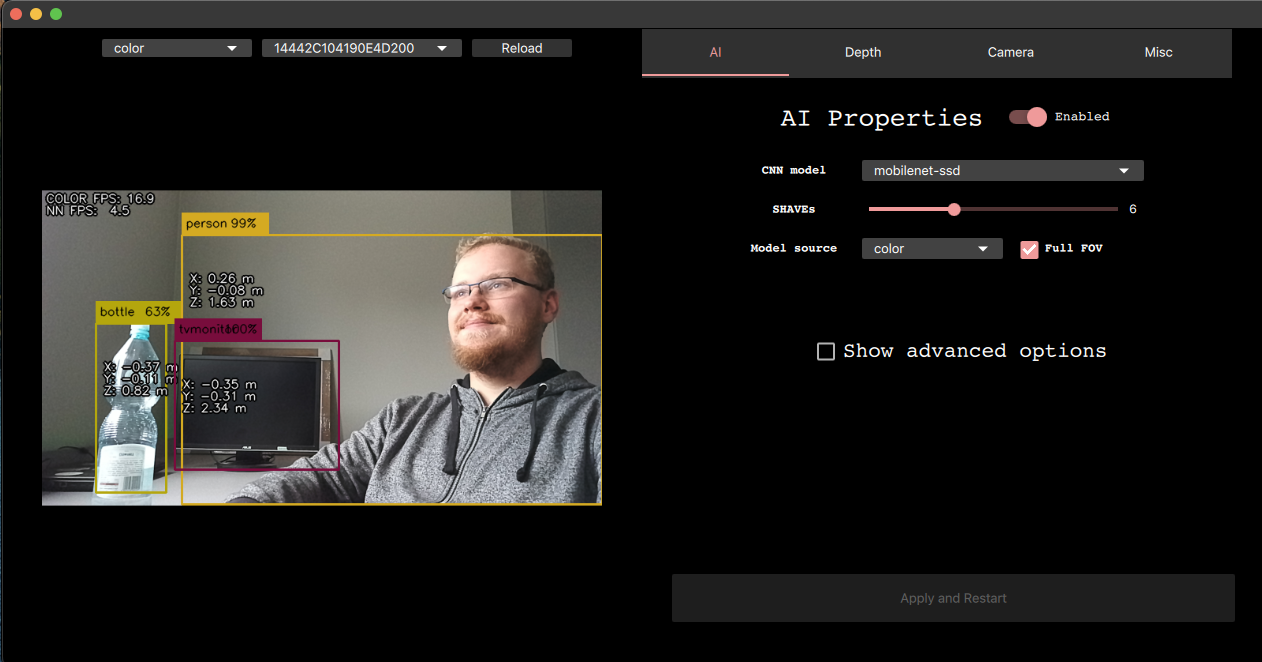This repo contains demo application, which can load different networks, create pipelines, record video, etc.
Click on the GIF below to see a full example run
Documentation is available at https://docs.luxonis.com/en/latest/pages/tutorials/first_steps/.
There are two installation steps that need to be performed to make sure the demo works:
-
One-time installation that will add all necessary packages to your OS.
$ sudo curl -fL https://docs.luxonis.com/install_dependencies.sh | bashPlease follow this installation page to see instructions for other platforms
-
Python dependencies installation that makes sure your Python interpreter has all required packages installed. This script is safe to be run multiple times and should be ran after every demo update
$ python3 install_requirements.py
This repository and the demo script itself can be used in various independent cases:
- As a tool to try out different DepthAI features, explorable either with command line arguments (with
--guiType cv) or in clickable QT interface (with--guiType qt) - As a quick prototyping backbone, either utilising callbacks mechanism or by extending the
Democlass itself - As a way to write code for DepthAI devices faster, using depthai-sdk managers and helper functions, on top of which the demo script is built
See instuctions here
Examples
python3 depthai_demo.py -gt cv - RGB & CNN inference example
python3 depthai_demo.py -gt cv -vid <path_to_video_or_yt_link> - CNN inference on video example
python3 depthai_demo.py -gt cv -cnn person-detection-retail-0013 - Runs person-detection-retail-0013 model from resources/nn directory
python3 depthai_demo.py -gt cv -cnn tiny-yolo-v3 -sh 8 - Run tiny-yolo-v3 model from resources/nn directory and compile for 8 shaves
Demo
For the full reference, run $ depthai_demo.py --help.
We currently have 2 apps, uvc and record.
This app will upload an UVC pipeline to the connected OAK camera, so you will be able to use an OAK as a webcam.
Record app lets you record encoded and synced video streams (MJPEG/H265) across all available devices into .mp4, Foxglove's .MCAP, or ROS' .bag . Since mono streams are synced, you will be able to reconstruct the whole stereo depth perception.
Run using $ depthai_demo.py -app record [-p SAVE_PATH] [-q QUALITY] [--save STREAMS] [-fc] [-tl]. More information about the arguments and replaying can be found here.
We have added support for a number of different AI models that work (decoding and visualization) out-of-the-box with the demo. You can specify which model to run with -cnn argument, as shown above. Currently supported models:
- deeplabv3p_person
- face-detection-adas-0001
- face-detection-retail-0004
- human-pose-estimation-0001
- mobilenet-ssd
- openpose2
- pedestrian-detection-adas-0002
- person-detection-retail-0013
- person-vehicle-bike-detection-crossroad-1016
- road-segmentation-adas-0001
- tiny-yolo-v3
- vehicle-detection-adas-0002
- vehicle-license-plate-detection-barrier-0106
- yolo-v3
If you would like to use a custom AI model, see documentation here.
By default, the demo script will collect anonymous usage statistics during runtime. These include:
- Device-specific information (like mxid, connected cameras, device state and connection type)
- Environment-specific information (like OS type, python version, package versions)
We gather this data to better understand what environemnts are our users using, as well as assist better in support questions.
All of the data we collect is anonymous and you can disable it at any time. To do so, click on the "Misc" tab and disable sending the statistics or create a .consent file in repository root with the following content
{"statistics": false}
We are actively developing the DepthAI framework, and it's crucial for us to know what kind of problems you are facing. If you run into a problem, please follow the steps below and email [email protected]:
- Run
log_system_information.shand share the output from (log_system_information.txt). - Take a photo of a device you are using (or provide us a device model)
- Describe the expected results;
- Describe the actual running results (what you see after started your script with DepthAI)
- How you are using the DepthAI python API (code snippet, for example)
- Console output






